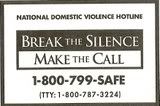Sanctuary for the Abused
Monday, October 29, 2018
Safety Nets Often Fail Abuse Victims

By SCOTT GUTIERREZ
Victims of domestic violence often turn to a neighbor instead of the police, and even if they sought court protection they often weren't given help to stay safe, according to a recent study of domestic violence homicides in Washington.
In addition, women of color were two or three times more likely than Caucasian women to be killed by an intimate partner, according to the report, and often faced cultural and language barriers to escaping an abusive relationship. The same trend was apparent with 43 men who have been killed since the biennial Domestic Violence Fatality Review began in 1997, according to the report.
The report, which was presented Monday by the Washington State Coalition Against Domestic Violence, looks at trends in domestic violence homicides in an effort to improve the criminal justice system and community response to better protect victims.
Sixty-eight people were killed as the result of domestic violence in the latest two-year period examined, between July 2006 and June 2008. Of those cases, 11 were chosen for an in-depth look.
In six of those cases, victims went to a neighbor or community member instead of calling the police. Private citizens often didn't know what to do and weren't aware of organizations that they could call for advice about how to help a victim of abuse.
In the past, the fatality review mostly focused on improving how police and courts handle domestic violence. This year, the focus shifted more toward how community members could better prepare if someone sought help from them, including how to help without jeopardizing their own safety, she said.
"In general, who do you turn to when in a crisis? I think most go to the people who are closest to us before we go to a stranger," said Kelly Starr, a coalition spokeswoman. "We can't rely on all of these systems as the answer."
The report recommended that block watches and crime-prevention groups learn more about domestic violence resources and share information. It also suggested that the media give contact information about advocacy services when reporting on domestic violence.
"I think the next piece is building the community's capacity to respond to this. We all have to build ourselves up so we're ready," Starr said.
Still, the report found areas where the court system needed improvement. For instance, victims often had no help from advocates when petitioning for court protection orders against their abusers. Without someone helping them make that decision, they could increase their risk in some cases, according to the report. An advocate can help plan where to go or what to do if the abuser retaliates or with deciding whether obtaining an order is the safest option.
One woman was killed last year in Federal Way just three hours after her boyfriend was served with an anti-harassment order.
In King County, the Prosecutor's Office provides a protection order advocacy program that victims have used in 73,000 cases since it was established 20 years ago. Generally, advocates serve about 5,000 cases each year, in addition to 2,500 walk-ins seeking advice, said David Martin, who supervises the domestic violence unit.
"For some folks, these are very difficult decisions to make -- life-altering decisions. There could be children involved, or a long-term relationship," Martin said. "We want people to understand what's going on and to make a good, informed decision."
Most Washington courts that provide protection orders, however, don't offer advocacy services, according to the report.
In those cases, court clerks' offices could consider referring victims to community-based organizations, which wouldn't cost extra money, Starr said.
SOURCE
Labels: abuse survivors, domestic violence, failure, harassment, hotline, protective order, safety, victims




























0 Comments:
Post a Comment
<< Home